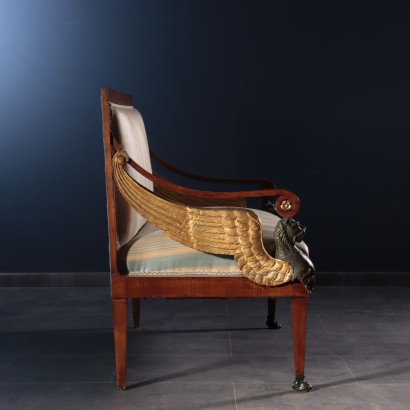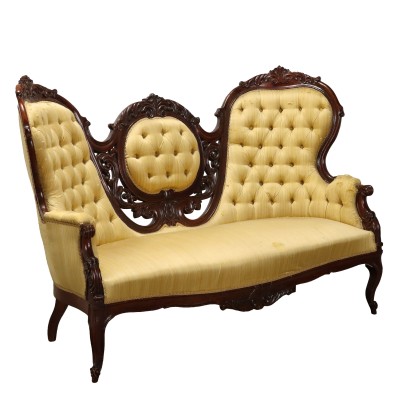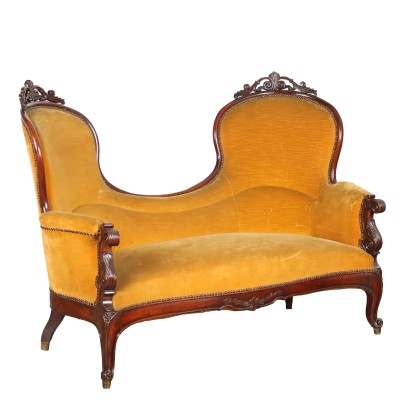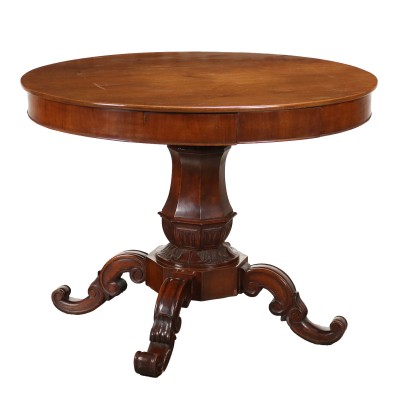Group of 4 Antique Restoration Settees Cherry Italy XIX Century - Lombard Veneto First Quarter 19th Century
Features
Lombard Veneto First Quarter 19th Century
Age: 19th Century / 1801 - 1900
Origin: Lombardo-Veneto, Italy
Main essence: Cherry
Description
Group of four settees supported by truncated pyramidal legs, the front ones have feet in the shape of feral paws. The uprights of the armrests are carved with the features of griffins, the lion bust is lacquered with an imitation burnishing, seeking a bronze effect; the wings are instead carved and gilded. On the head of the griffin rests the curl of the wavy armrest, within which a rose window, also gilded, is carved. In walnut veneered in cherry, the armrest is in solid cherry and has a recessed recessed wrought iron reinforcement. The seat and back are padded.
Product Condition:
Product in good condition, with small signs of wear.
Dimensions (cm):
Height: 98
Width: 104
Depth: 54
Additional Information
Notes historical bibliographic
The four sofas belong to a lounge from the Restoration period, which can be circumscribed to the geographical area of Lombardy-Veneto; the materials used also refer to this area. Especially in the carving of the griffins, an Austrian influence is perceived, especially in the lacquer of the wood with fake bronze. There is some evidence, especially for the way the armrests and their uprights are developed, with designs for seats (armchair and sofa) by Domenico Moglia, published in 1837. Comparisons are also possible with some of the furnishings designed by Giuseppe Borsato and published in the 1831 in his ornamental work. In table 26 and in the engraving of the frontispiece, in fact, the seat and chair of Leopoldo Cicognara are depicted, for which we can see a similar modality in the adoption of tall lions as a support for the top or in the armrests. An interesting correspondence is, however, above all the analogous solution in the chromatic contrast between the wood used (in this case a blond walnut) and the feral legs and heads ebonized. Interesting and a sign of the high quality of the seats is the foresight to reinforce the thin cherry armrest with a wrought iron support, in order to avoid breaking it and allow the support of a heavier weight, while preserving its lightness and elegance. The small size that makes the group of sofas more interesting is curious and rare.Age: 19th Century / 1801 - 1900
19th Century / 1801 - 1900Main essence: Cherry
Obtained from prunus cerasus , a plant of oriental origin, it is a hard wood with a light and delicate color, with a reddish vein. Due to its diffusion and availability it was used in Europe in popular furniture. In cabinet making, in the seventeenth century, it was widely used in France and England for inlay work. In Italy it was very successful in Lucca. It was also very popular in the United States for the manufacture, from the late 1600s, of commonly used furniture.The dictionary of antiques: Eclecticism
Classic Monday: a sofa from the 1800s example of eclecticism
Other customers have searched:
Divano, duchesse brisée, dormeuse, ottomana, canapè, sofà..
Tutto quello che c'è da sapere sui divani lo trovi nel nostro blog e su FineArt:
Leggi di più
Un divano dell''800 esempio di eclettismo
Un divano neoclassico emiliano in cui un dettaglio è importante: Il nodo d'amore
Storia della dormeuse
Divano modulare Camaleonda di Mario Bellini
Divano "IX Triennale" Marco Zanuso per Arflex
Divano due posti 'Soriana', Afra & Tobia Scarpa per Cassina
Divano "D70", Osvaldo Borsani per Tecno
Quattro Divanetti lombardo-veneto del XIX secolo
Sull'antiquariato in generale dai un'occhiata anche a:
Classic Monday: da un pezzo dei nostri magazzini alla storia dell'antiquariato
L'antiquariato dalla A alla Z: il Dizionario dell'Antiquariato
Il dizionario dell'antiquariato - Lastronatura
Il dizionario dell'antiquariato - Mascherone
Il dizionario dell'antiquariato - Natura morta
Il dizionario dell'antiquariato - Opificio
Il dizionario dell'antiquariato - Pastiglia
Il dizionario dell'antiquariato - Savonarola
Il dizionario dell'antiquariato - Rosone
Classic Monday: da un pezzo dei nostri magazzini alla storia dell'antiquariato
L'antiquariato dalla A alla Z: il Dizionario dell'Antiquariato
Leggi di più
Un divano dell''800 esempio di eclettismoUn divano neoclassico emiliano in cui un dettaglio è importante: Il nodo d'amore
Storia della dormeuse
Divano modulare Camaleonda di Mario Bellini
Divano "IX Triennale" Marco Zanuso per Arflex
Divano due posti 'Soriana', Afra & Tobia Scarpa per Cassina
Divano "D70", Osvaldo Borsani per Tecno
Quattro Divanetti lombardo-veneto del XIX secolo
Sull'antiquariato in generale dai un'occhiata anche a:
Classic Monday: da un pezzo dei nostri magazzini alla storia dell'antiquariato
L'antiquariato dalla A alla Z: il Dizionario dell'Antiquariato
Il dizionario dell'antiquariato - Lastronatura
Il dizionario dell'antiquariato - Mascherone
Il dizionario dell'antiquariato - Natura morta
Il dizionario dell'antiquariato - Opificio
Il dizionario dell'antiquariato - Pastiglia
Il dizionario dell'antiquariato - Savonarola
Il dizionario dell'antiquariato - Rosone
Classic Monday: da un pezzo dei nostri magazzini alla storia dell'antiquariato
L'antiquariato dalla A alla Z: il Dizionario dell'Antiquariato












































